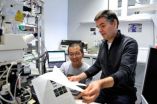(Press-News.org) The world population is rapidly ageing, which means the number of disabled and dependent people is increasing since these rates increase with age, particularly after the age of 80. This is the context in which the Tecnalia centre for applied research has designed a system of sensors which when fitted in a home, allows a person's habits and activities to be monitored and any changes in his/her habits and activities that could be a symptom of disorders relating to neurodegenerative diseases like Alzheimer's to be detected.
Since the symptoms of diseases like Alzheimer's are linked at an early stage to changes in behaviour in the carrying out of activities in everyday life, an early diagnosis will allow the disease to be tackled right from the early stages of cognitive deterioration, thus delaying its effects and improving the patient's quality of life. To this has to be added that according to data of Imserso (Spanish Institute for the Elderly and Social Services), 70% of people over 70 prefer to go on living in their own homes rather than go into a care home.
To tackle these new challenges, Tecnalia is working on initiatives based on assistive technology like a system of sensors that allows a person's activities and habits to be monitored and any changes and activities that could be a symptom of disorders relating to neurodegenerative diseases like Alzheimer's to be detected. Through a broad network of sensors distributed throughout the home, this system is capable of detecting the presence of the user in different rooms, the opening and closing of doors, windows, drawers, the switching on and off of lights, the use of household appliances, the television, time spent in bed, on the sofa, the use of taps, etc. From the more technological point of view, one feature in the system is the use of sound sensors to pick up, for example, the ringing of the phone or the doorbell.
The system records, in real time, the information from the sensors and identifies the activity that the person is doing, like preparing a meal, watching the TV while sitting on the sofa or having a shower. This monitoring allows the person's habits or routines to be learnt in order to subsequently be able to spot any changes in them which could point to memory problems or disorders, disorientation in time and space, giving up activity, or becoming isolated; in many cases these may be symptoms of a neurodegenerative disease, and that way a relative or carer could be alerted about them. For example, this monitoring can detect changes in sleep patterns, in eating habits like stopping eating hot meals, inactivity when more time is spent sitting or watching TV, wandering around the house, etc.
The system also enables people to receive assistance in carrying out everyday activities, for example, by means of alarms or domestic robots. These devices could remind them that it is time for them to take their medication or to do some activity.
Future steps
Following three years of research, the prototype of the system has now been fitted on the premises of Tecnalia in Zamudio (Bizkaia, Basque Country). The aim is for care homes for the elderly or supervised flats to install this system and thus improve the care of the patients and their quality of life.
INFORMATION:
It should be pointed out that the following consortium has collaborated on the initiative, known as RUBICON and partly funded by the European Commission through its 7th Framework Programme: University College Dublin; Consiglio Nazionale Delle Richerche; Örebro University; the TECNALIA centre for applied research; Robotnik Automation SLL; University of Ulster; Università Di Pisa; Pintail LTD and the Fondazione Stella Maris.
Tecnalia presents a smart home able to detect symptoms of neurodegenerative diseases
2014-03-24
ELSE PRESS RELEASES FROM THIS DATE:
'MaMTH' advance: New technology sheds light on protein interactions
2014-03-24
TORONTO — Scientists have a better way to study human proteins — large molecules that are part of every cell in the body — thanks to a new technology developed by University of Toronto researchers. The technology tracks a class of proteins called membrane proteins as they interact with other proteins to either maintain health or contribute to disease.
Membrane proteins make up about one third of all proteins in the human body, and their malfunction is associated with more than 500 diseases. But they've been hard to study because understanding their role depends on observing ...
Experiment opens the door to multi-party quantum communication
2014-03-24
In the world of quantum science, Alice and Bob have been talking to one another for years. Charlie joined the conversation a few years ago, but now with spacelike separation, scientists have measured that their communication occurs faster than the speed of light.
For the first time, physicists at the Institute for Quantum Computing (IQC) at the University of Waterloo have demonstrated the distribution of three entangled photons at three different locations (Alice, Bob and Charlie) several hundreds of metres apart, proving quantum nonlocality for more than two entangled ...
Fast and reliable: New mechanism for speedy transmission in basket cells discovered
2014-03-24
This news release is available in German.
In his third major research paper since December 2013, IST Austria Professor Peter Jonas together with his collaborator, postdoc Hua Hu, identifies a new subcellular mechanism for reliable, fast transmission in the so-called basket cells of the brain. The results will be published on the website of Nature Neuroscience on March 23, 2014 (DOI 10.1038/nn.3678)
IST Austria president Thomas Henzinger expressed his delight: "This is an extraordinary streak of publications in major journals which once more emphasizes the outstanding ...
Heparin might be the key to prevent prion conversion and disease
2014-03-24
Prions are infectious agents responsible for neurodegenerative diseases such as bovine spongiform encephalitis (commonly known as "mad cow disease") and Creutzfeldt–Jakob disease in humans.
Since the discovery in the 60s that an incurable and fatal disease could be caused by an infectious agent formed by nothing but converted misfolded proteins, the mechanisms responsible for the conversion of a normal prion protein into its infectious counterpart – the scrapie prion – have been relentlessly investigated. Researchers now know that once converted into the scrapie form, ...
p53 cuts off invading cancer cells
2014-03-24
VIDEO:
In the absence of Omi, Ras-transformed tumor cells form invasive lamellipodial protrusions.
Click here for more information.
The tumor suppressor p53 does all it can to prevent oncogenes from transforming normal cells into tumor cells by killing defective cells or causing them to become inactive. Sometimes oncogenes manage to initiate tumor development in the presence of p53, but, even then, the tumor suppressor doesn't give up and focuses its efforts instead on limiting ...
How developing sperm stick to the right path
2014-03-24
The process of producing high-quality, fertile sperm requires many steps. A study in The Journal of Cell Biology shows how the transcription factor p73 promotes this process by regulating the adhesions between developing sperm and their support cells.
The p53 family of transcription factors has an ancient and well-conserved function in protecting reproductive cells. In mammals, for example, p63 promotes the death of eggs and sperm that have sustained DNA damage, and female mice lacking p73 are infertile due to defects in egg development. Male mice lacking p73 are also ...
Radiation therapy and cancer vaccines: Timing is everything
2014-03-24
(PHILADELPHIA) – Radiation therapy fights cancer in more ways than one. Not only does it force cancer cells to self-destruct, but several studies demonstrate that it also activates the immune system to attack tumor cells. This activation can be used to boost current immunotherapies, such as anti-tumor vaccines, to produce better clinical results. What's less clear, however, is exactly how to combine the two therapies to get the best bang for the therapeutic buck.
To address this question, researchers at Thomas Jefferson University tested an experimental cancer vaccine ...
Unfolded proteins collapse when exposed to heat and crowded environments
2014-03-24
Proteins are important molecules in our body and they fulfil a broad range of functions. For instance as enzymes they help to release energy from food and as muscle proteins they assist with motion. As antibodies they are involved in immune defence and as hormone receptors in signal transduction in cells. Until only recently it was assumed that all proteins take on a clearly defined three-dimensional structure – i.e. they fold in order to be able to assume these functions. Surprisingly, it has been shown that many important proteins occur as unfolded coils. Researchers ...
Diabetes drug shows promise in reducing Alzheimer's disease in an experimental model
2014-03-24
(Boston) Researchers from Boston University School of Medicine (BUSM) have found that the diabetic drug, pramlintide, reduces amyloid-beta peptides, a major component of Alzheimer's disease (AD) in the brain and improves learning and memory in two experimental AD models. These findings, which appear online in Molecular Psychiatry, also found AD patients have a lower level of amylin in blood compared to those without this disease. These results may provide a new avenue for both treatment and diagnosis of AD.
AD is a degenerative brain disease associated with severe functional ...
Fair bosses pay a price
2014-03-24
EAST LANSING, Mich. — Bosses who are fair make their workers happier and their companies more productive, but in the end may be burning themselves out.
A new study led by Michigan State University's Russell E. Johnson found the act of carefully monitoring the fairness of workplace decisions wears down supervisors mentally and emotionally.
"Structured, rule-bound fairness, known as procedural justice, is a double-edged sword for managers," said Johnson, assistant professor of management. "While beneficial for their employees and the organization, it's an especially draining ...




